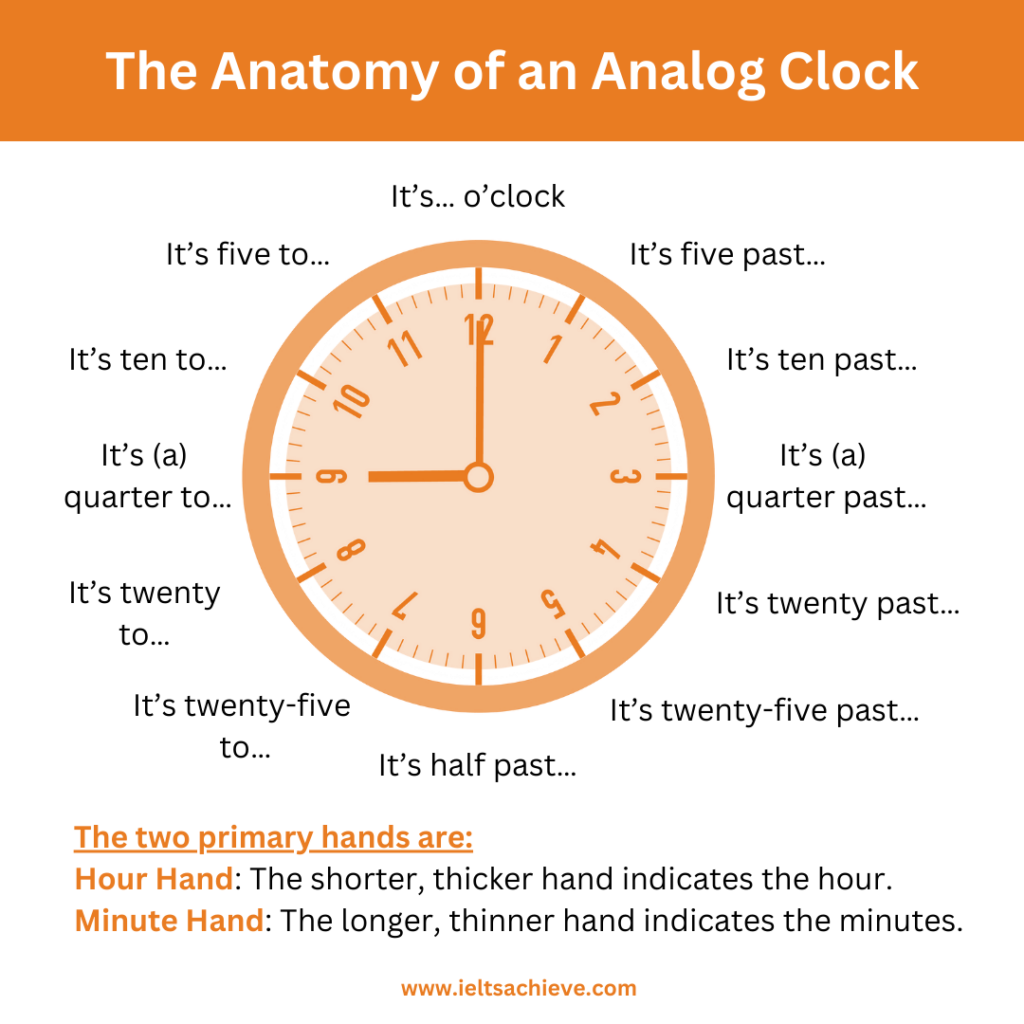In the era of digital clocks and smartphones, the art of reading an analog clock might seem like a relic of the past. However, mastering this fundamental skill offers several benefits, from enhancing your understanding of numbers to improving your time management abilities.
The Anatomy of an Analog Clock
An analog clock is a timepiece that displays the time using hands that rotate around a circular dial marked with numbers. The two primary hands are:
- Hour Hand: The shorter, thicker hand indicates the hour.
- Minute Hand: The longer, thinner hand indicates the minutes.
The Dial: A Canvas for Time
The dial, the circular face of the clock, is divided into 12 equal sections, each representing an hour. The number 12 sits at the top, followed by the numbers 1 to 11 in a counterclockwise direction.

Time Expressions: A Dance of Hands
To express time using an analog clock, we observe the position of the hands and use specific phrases:
- “It’s… o’clock”: When the minute hand points to 12, it signifies the beginning of an hour. For instance, “It’s three o’clock” indicates the start of the third hour.
- “It’s five past…”: With the minute hand pointing to 1, five minutes have elapsed since the hour. Similarly, “It’s ten past four” means ten minutes have passed since four o’clock.
- “It’s (a) quarter past…”: When the minute hand reaches 3, a quarter of the hour has passed. For example, “It’s a quarter past eight” implies that 15 minutes have passed since eight o’clock.
- “It’s twenty past…”: At 4, the minute hand indicates twenty minutes past the hour. For instance, “It’s twenty past one” means twenty minutes have passed since one o’clock.
- “It’s twenty-five past…”: When the minute hand reaches 5, it represents twenty-five minutes past the hour. Similarly, “It’s twenty-five past six” means twenty-five minutes have passed since six o’clock.
- “It’s half past…”: With the minute hand at 6, it signifies the halfway point of the hour, equivalent to thirty minutes past. For instance, “It’s half past nine” means thirty minutes have passed since nine o’clock.
Counting Down to the Next Hour
As we move past the bottom of the hour, we begin counting down to the next hour:
- “It’s twenty-five to…”: When the minute hand reaches 7, it indicates twenty-five minutes to the upcoming hour. For example, “It’s twenty-five to ten” means twenty-five minutes remain until ten o’clock.
- “It’s twenty to…”: At 8, twenty minutes remain until the next hour. Similarly, “It’s twenty to five” means twenty minutes remain until five o’clock.
- “It’s (a) quarter to…”: With the minute hand pointing to 9, it represents forty-five minutes past the previous hour, or a quarter to the next hour. For instance, “It’s a quarter to six” indicates that 45 minutes have passed since five o’clock, leaving 15 minutes until six o’clock.
- “It’s ten to…”: When the minute hand reaches 10, it means ten minutes remain until the next hour. Similarly, “It’s ten to seven” implies that ten minutes remain until seven o’clock.
- “It’s five to…”: At 11, it signifies five minutes to the next hour. For instance, “It’s five to twelve” means five minutes remain until twelve o’clock.
Contextualizing Time Expressions
The way we express time using an analog clock depends on the context:
- “AT+TIME” for Specific Events: When referring to the time of a specific event, we use “at” followed by the time. For example, “The meeting starts at nine o’clock.”
- “IT IS or IT’S” for Current Time: To respond to a question about the current time, we use “it is” or “it’s”. For instance, “What time is it? It’s ten to three.”
Practical Examples
To solidify the concepts of reading an analog clock, let’s consider some practical examples:
- It’s… o’clock
- Example: When both hands are at 12, it’s 12 o’clock – the start of a new day or noon.
- It’s five past…
- Example: If the hour hand is just after the 3 and the minute hand is on the 1, it’s five past three.
- It’s ten past…
- Example: When the hour hand is between the 10 and the 11, and the minute hand is on the 2, it’s ten past ten.
- It’s (a) quarter past…
- Example: If the hour hand points towards the 8 and the minute hand is at 3, it’s a quarter past eight.
- It’s twenty past…
- Example: With the hour hand just past the 5 and the minute hand on the 4, it’s twenty past five.
- It’s twenty-five past…
- Example: When the hour hand is nearing the 2 and the minute hand is at the 5, it’s twenty-five past one.
- It’s half past…
- Example: If the hour hand is halfway between the 11 and the 12, and the minute hand is at 6, it’s half past eleven.
- It’s twenty-five to…
- Example: When the hour hand is just past the 9 and the minute hand is at the 7, it’s twenty-five to ten.
- It’s twenty to…
- Example: With the hour hand a bit after the 4 and the minute hand on the 8, it’s twenty to five.
- It’s (a) quarter to…
- Example: If the hour hand is closing in on the 6 and the minute hand is at 9, it’s a quarter to six.
- It’s ten to…
- Example: When the hour hand is nearly at the 7 and the minute hand is at the 10, it’s ten to seven.
- It’s five to…
- Example: If the hour hand is almost on the 12 and the minute hand is on the 11, it’s five to twelve.
Practice Questions and Answers
To further reinforce your understanding of analog clock reading, try answering these practice questions:
- Question 1: The hour hand is on the 4 and the minute hand is on the 12. What time is it?
- Answer: It’s four o’clock.
- Question 2: The hour hand is just past the 7 and the minute hand is on the 6. What time is it?
- Answer: It’s half past seven.
- Question 3: The hour hand is between the 1 and the 2, and the minute hand is on the 9. What time is it?
- Answer: It’s a quarter to two.
- Question 4: The hour hand is on the 9 and the minute hand is on the 3. What time is it?
- Answer: It’s nine o’clock.
- Question 5: The hour hand is just before the 12 and the minute hand is on the 2. What time is it?
- Answer: It’s ten past eleven.

